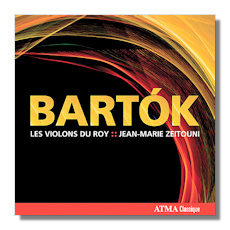
The Internet's Premier Classical Music Source
Related Links
- Bartók Reviews
- Latest Reviews
- More Reviews
-
By Composer
-
Collections
DVD & Blu-ray
Books
Concert Reviews
Articles/Interviews
Software
Audio
Search Amazon
Recommended Links
Site News
 CD Review
CD Review
Béla Bartók

- Divertimento
- Music for Strings, Percussion, and Celesta
- Romanian Folk Dances (orch. Zeitouni)
Les Violons du Roy/Jean-Marie Zeitouni
Atma Classique ACD2-2576 DDD 64:48
Bartók on period instruments? You might think so, given the name of the ensemble. Québec-based Les Violons du Roy, founded in 1988, is associated primarily with Baroque music. They play, however, on modern instruments, modifying their playing style to suit the repertory at hand. In other words, those in search of catgut Bartók will have to look elsewhere. Their previous discs for Atma Classique – Handel's Water Music and a Piazzolla program (!) – suggest that this isn't a predictable group of musicians.
The playing on this Bartók CD is so smooth and soft grained that it is almost revisionist. There is little of the bite and the eerie atmosphere that we associate with Bartók, especially with the Music for Strings, Percussion, and Celesta. The performance seems to fade to grey right before our very ears. On the other hand, the Romanian Folk Dances are done with an ear for their ethnic origin; the rhythms bounce, and the angles are sharper than elsewhere on this CD. This is Zeitouni's wn orchestration of what originally was a suite of piano works. Bartók himself arranged these Romanian Folk Dances for chamber orchestra and winds. Zeitouni's rchestration is for strings, percussion, and celesta. You guessed it – Zeitouni devised this orchestration to match the scoring of Music for Strings, Percussion, and Celesta, presumably so they could be on the same concert (and CD) program. This is a harmless conceit; it doesn't bother me a bit, and is effective.
The recording venue complements the performers and their rather plummy style, and the engineers have captured it all with warmth and clarity. Generally speaking, this is not my idea of Bartók, but it makes an interesting alternative to the consensus.
Copyright © 2009, Raymond Tuttle




















